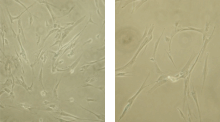WI-38
WI-38 ( Wistar Institute -38) is a diploid human cell culture line . It is based on fibroblastic cells that originally came from the lungs of a 3-month-old female fetus . This was aborted in Sweden in 1961 . The healthy mother stated that the reason for the abortion was that she did not want to enlarge her family any further. The fetus was sent to the Karolinska Institute in Stockholm after the abortion . There, the lung tissue of the fetus was isolated and transferred to the US Wistar Institute, where Stanley Plotkin was researching a rubella and Tadeusz "Tad" Wiktor was researching a rabies vaccine. At the Institute have Leonard Hayflick and Paul S. Moorhead finally established the cell line 1962nd In 1963, the development of the first successful vaccine based on the WI-38 cell line, a polio vaccine, followed by gradually vaccines against measles , mumps , rubella , rabies , chickenpox and hepatitis A .
The WI-38 cells do not have the ability to cause tumors and have a low frequency of chromosomal abnormalities. They can also be frozen indefinitely.
application
In the early 1960s, Hayflick and Moorhead discovered that viruses required for certain vaccinations develop better in human stem cells in the laboratory than in animal tissue or living animals. The latter had often been used before for production and cultivation, so z. As previously used kidney cells from monkeys . With that production method from kidney tissue, however, it happened again and again that these also contained unwanted pathogens, while the cells originally obtained from the fetus enabled safe virus and thus vaccine production.
Infected WI-38 cells can shed the virus and cultured for large-scale commercial production. The viruses are cleaned for the vaccine and remnants of the cell culture are removed, but they may find their way into the vaccine as traces. According to Paul Ehrlich Institute are these possible residues of the cell line cultures no ingredients but aids in the production, since they are not "deliberately inflicted".
It is estimated that in the US alone, vaccine development based on the WI-38 cell line had protected around 200 million people from dangerous infections by 2015. Around 450,000 people would have died prematurely in the United States without the vaccinations.
Today, in addition to WI-38, the cell line MRC-5 , which is also derived from a fetus, is mainly used for the development of a large number of vaccines. In either case, the fetuses were not aborted for tissue removal for the cell lines. The cell lines were removed from the fetuses once and then continuously multiplied and frozen.
It has been criticized in particular by religious communities that the WI-38 cell line (and also MRC-5) was obtained from an aborted fetus. The Catholic Church as well as other religious communities consider the production of such vaccines to be justified in terms of their usefulness. In 2003, the future Pope Benedict XVI. ( Joseph Ratzinger ) just praised the rubella vaccine. In a 2017 statement, the Pontifical Academy for Life also advocated the use of such vaccines as justifiable.
See also
Web links
- Meredith Wadman: Medical research: Cell division . In: Nature News . tape 498 , no. 7455 , June 27, 2013, p. 422 , doi : 10.1038 / 498422a .
Individual evidence
- ↑ FAQ vaccines. Federal Office for Safety in Healthcare, September 13, 2019, accessed on January 11, 2020 (Austrian German).
- ↑ L. Hayflick and PS Moorhead: The serial cultivation of human diploid cell strains . In: Experimental Cell Research . tape 25 , no. 3 , December 1, 1961, p. 585-621 , doi : 10.1016 / 0014-4827 (61) 90192-6 .
- ↑ WI-38 ATCC® CCL-75 ™ Homo sapiens lung normal. American Type Culture Collection, accessed January 11, 2020 .
- ↑ a b c d Vaccinations: How An Abortion Helped Save Millions of Lives. Der Spiegel , March 6, 2017, accessed on January 11, 2020 .
- ^ Paul A. Offit and Charlotte A. Moser: Vaccines & Your Child: Separating Fact from Fiction . Columbia University Press, 2011, ISBN 978-0-231-15307-2 , pp. 85 .
- ↑ Timeline. Wistar Institute, accessed January 11, 2020 .
- ↑ T. Betáková et al .: Overview of measles and mumps vaccine: origin, present, and future of vaccine production . In: Acta Virologica . tape 57 , no. 2 , 2013, p. 91-96 , doi : 10.4149 / av_2013_02_91 , PMID 23600866 .
- ^ SJ Olshansky and L. Hayflick: The Role of the WI-38 Cell Strain in Saving Lives and Reducing Morbidity . In: AIMS public health . tape 4 , no. 2 , March 2, 2017, p. 127-138 , doi : 10.3934 / publichealth.2017.2.127 , PMID 29546209 , PMC 5689800 (free full text).
- ↑ a b Ralf Nowotny: Were cancer cells discovered in vaccines? (Fact check). In: mimikama . January 9, 2020, accessed January 9, 2020 .
- ↑ a b Stanley A. Plotkin et al .: Plotkin's Vaccines . 7th edition. Elsevier, Philadelphia 2017, ISBN 978-0-323-35761-6 , pp. 1594 ( elsevier.com ).
- ↑ a b c Joana Splieth: No, cells from human fetuses and monkeys or glyphosate are not ingredients of vaccinations. In: corrective . December 13, 2019, accessed January 9, 2020 .
- ↑ David Gorski: How "aborted fetal cells" contributed to vaccines preventing billions of cases of disease and many million deaths. ScienceBlogs , March 7, 2017, accessed January 12, 2020 .
- ↑ Liz Neporent: What Aborted Fetuses Have to Do With Vaccines. In: ABC News . February 17, 2015, accessed January 10, 2020 .
- ^ Note on Italian vaccine issue. In: Pontifical Academy for Life. July 31, 2017, accessed May 1, 2020 .
